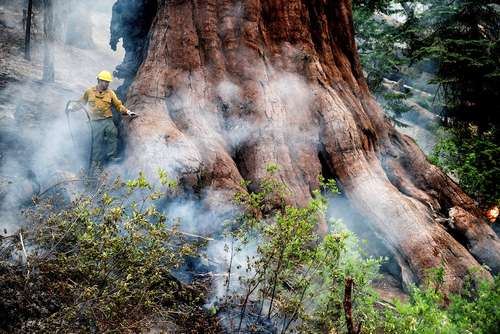Firefighters in California are battling to put out a massive blaze that is destroying Yosemite National Park, putting some of the oldest trees in the world in grave danger.
One of California's most well-known sequoia trees, the 3,000-year-old Grizzly Giant, is safeguarded with a sprinkler system and a vintage cottage that has been foil-wrapped to prevent fire.
In order to safeguard a famous grove of old trees from the flames, which has doubled in size recently, authorities have cleared trash from the forest floor and employed controlled fires.
The week's warmer and dryer weather is expected to make it considerably harder for firefighters to put out the fires they are already fighting.
There are more than 500 huge sequoia trees in the Mariposa Grove, which has been affected by the fire, raising concerns that the trees may be lost.

To put out the 200+ foot tall trees, a sprinkler system has been installed. In the nineteenth century, Yosemite's first "guardian" lived in Galen Clark's cabin, which has since been covered in foil.
According to Robbie Johnson of the California Department of Forestry and Fire Protection, authorities surrounded the sequoias with a "doughnut hole" screen.
Campers, hotel guests, and locals close to the fire have been evacuated, but the majority of Yosemite, a Unesco World Heritage site, is still accessible. Air quality warnings have been issued as a result of the fire's thick smoke, the source of which is being examined.
The sequoias had a terrible year last year. 3,600 trees, or between 3 and 6 percent of the sequoia trees in the world, were destroyed by wildfires in northern California.
In the renowned Mariposa Grove, more than 500 mature sequoias were in danger, although no recognized trees, including the 3,000-year-old Grizzly Giant, were reported to have suffered major damage.
The grove's sprinkler system kept the tree trunks damp, and officials hoped that the combination of past planned burns and the steady stream of water would be sufficient to stave off fires, according to Ms. Phillipe.
The Washburn Fire's origin was still being looked into. By Sunday morning, it had expanded to almost 6.7 square kilometers without containment.
Beyond the trees, the Wawona neighborhood, which is encircled by parkland, was in danger; late on Friday, residents were told to leave.
In addition to inhabitants, some 600 to 700 people residing in tents, huts, and a historic hotel at the Wawona campground were also asked to depart.
The huge sequoias, which are native to only 70 groves scattered along the western slope of the Sierra Nevada mountain range in California, were formerly thought to be impenetrable to fire but are now becoming more and more vulnerable.
Due to a century of fire suppression, there has been an increase in undergrowth, which has caused wildfires to spread more quickly and more destructively.

Prior to Sunday, Ms. Phillipe, the park's spokesperson, said that some of the enormous trunks had been wrapped in fire-resistant foil for safety, but she later clarified that this was not the case for this particular incident.
She added that workers have, however, wrapped a historic cabin in the protective foil.
Up to a fifth of the estimated 75,000 huge sequoia trees, which are the largest trees by volume and a main lure for visitors to the national park, have perished in lightning-sparked wildfires during the previous two years.
According to Ms. Phillipe, there was no clear natural spark for the fire that started on Thursday near to the Washburn Trail in the park.
Visitors who were strolling through the grove, which reopened in 2018 following a $US40 million refurbishment that took three years, reported seeing smoke.
Over a year ago, a powerful windstorm collapsed 15 big sequoia trees in addition to many other trees throughout the grove.
The large quantity of pine trees killed by bark beetles and the downed trees supplied plenty of fuel for the flames.
According to the National Interagency Fire Center, more than 35,000 wildfires have burnt roughly 4.7 million acres in the US so far in 2022, which is significantly more than the national average for both wildfires and acres burned.
